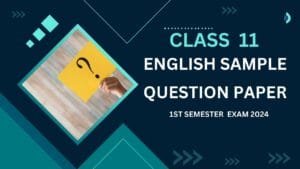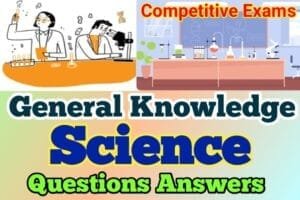The title English Sample Question Paper Class 11 1st Semester (2024) refers to a model exam paper designed for Class 11 students for their first-semester exams in 2024. It provides practice questions based on the current syllabus to help students prepare effectively. This paper follows the WBCHSE pattern and covers key topics in the English curriculum.
English (B) Sample Questions
Class XI
1st Semester 2024
F.M – 40 Time: 1h15min
Instructions:
- The Question paper consists of 5 UNITS
- UNIT 1 contains 10 marks
- UNIT 2 contains 10 marks
- UNIT 3 contains 10 marks
- UNIT 4 contains 5 marks
- UNIT 5 contains 5 marks
- All Questions are Compulsory
- Each question carries 1 mark
UNIT 1: Prose
1. How did Guru Nayak feel about the astrologer’s final advice?
a) Angered
b) Relieved
c) Gratified
d) Confused
2. What did the astrologer’s wife think of his job?
a) She was proud
b) She did not understand it
c) She was indifferent
d) She disapproved of it
3. What was the astrologer’s attitude towards his own predictions?
a) He believed in them deeply
b) He saw them as shrewd guesswork
c) He was indifferent to them
d) He thought they were divinely inspired
Download Class 11 English (B) Suggestions 1st Semester PDF 2024
The notes cover a variety of MCQ questions and answers from prose, poetry, the rapid reader, and grammar. Get your complete PDF copy in one place now and start studying with confidence!

4. What did the astrologer feel about his profession?
a) It was dishonest
b) It was as honest as any other labor
c) It was a calling
d) It was unimportant
5. What emotion does the Swami associate with the worship of the Divine Mother?
a) Fear
b) Reverence
c) Indifference
d) Anger
6. How does Sister Nivedita characterize the Swami’s teachings on the Divine Mother?
a) Simplistic
b) Deeply philosophical and complex
c) Contradictory
d) Unoriginal
7. How does the Swami’s approach to Mother-worship differ from dogmatic religious practices?
a) It is more rigid
b) It is more flexible and inclusive
c) It is more focused on external rituals
d) It is less spiritual
8. What was the most striking aspect of the pilgrimage for a foreign observer?
a) The religious fervor
b) The physical challenges
c) The organizational efficiency
d) The cultural diversity
9. How did the Swami’s experience at Amarnath change his perspective on life and death?
a) It filled him with fear of death
b) It made him indifferent to life and death
c) It strengthened his belief in an afterlife
d) It led him to question the meaning of life
10. What was the most significant personal sacrifice made by the Swami during the pilgrimage?
a) Giving up his wealth
b) Enduring physical hardship
c) Leaving his family behind
d) Abandoning his worldly possessions
UNIT 2: Verse
11. What is the effect of the morning on the poet’s soul?
a) Dull
b) Restless
c) Deeply calm
d) Anxious
12. Which of the following structures is mentioned in the poem?
a) Castles
b) Ships, towers, domes
c) Bridges
d) Parks
13. The river is described as:
a) Raging violently
b) Gliding at its own sweet will
c) Rapid and noisy
d) Completely still
14. How does the poet describe the houses in the city?
a) Lively and busy
b) Chaotic and loud
c) Asleep
d) Moving
15. Which line in the poem indicates the culmination of a woman’s life in terms of family and responsibilities?
a) “Some are meet for a maiden’s wrist”
b) “For she who has journeyed through life midway”
c) “Some are like fields of sunlit corn”
d) “Or rich with the hue of her heart’s desire”
16. The repetition of the word “happy” in the poem serves to highlight what?
a) The joy and fulfillment associated with traditional roles
b) The monotony of life
c) The sadness hidden behind smiles
d) The fear of the unknown
17. How does the poem “The Bangle Sellers” reflect Indian traditions?
a) By describing Indian festivals
b) Through the symbolism of bangles in a woman’s life
c) By criticizing Indian customs
d) By depicting historical events
18. How does the poem view the passage of time?
a) As progressive and positive
b) As cyclic and destructive
c) As linear and predictable
d) As stagnant and unchanging
19. What is the mood of the poem?
a) Joyful
b) Reflective
c) Despairing
d) Comedic
20. Which literary technique is used in the line “The best lack all conviction, while the worst / Are full of passionate intensity”?
a) Irony
b) Hyperbole
c) Simile
d) Oxymoron
UNIT 3: Rapid Reader
21. What motivates Macbeth’s initial thoughts of murder?
a) The witches’ prophecy
b) Lady Macbeth’s persuasion
c) His desire for power
d) All of the above
22. How does Lady Macbeth convince Macbeth to commit the murder?
a) By questioning his manhood
b) By promising him glory
c) By threatening to leave him
d) By appealing to his ambition
23. What does Macbeth see before committing the murder that leads him to question his actions?
a) A floating dagger
b) The ghost of Banquo
c) The witches’ cauldron
d) Lady Macbeth’s reflection
24. Who discovers Duncan’s murder?
a) Lady Macbeth
b) Macduff
c) Banquo
d) Malcolm
25. What advice did Iago give to Othello about Desdemona?
a) To trust her completely
b) To keep an eye on her
c) To divorce her immediately
d) To leave her in Venice
26. What emotion began to consume Othello after Iago’s manipulations?
a) Joy
b) Fear
c) Jealousy
d) Indifference
27. What was the outcome of Othello’s confrontation with Desdemona?
a) Reconciliation
b) Violence
c) Divorce
d) Escape
28. Who did Duke Frederick initially believe was responsible for Rosalind’s disappearance?
a) Celia
b) Orlando
c) The rightful Duke
d) The court jester
29. Who joined Duke Frederick in his quest to find the banished Duke?
a) Orlando
b) Oliver
c) His loyal followers
d) A mercenary army
30. How did Rosalind’s disguise as Ganymede help her in the forest?
a) It protected her from danger
b) It allowed her to communicate freely
c) It made her stronger
d) It made her invisible
UNIT 4: Textual Grammar
31. Because he fought so long, he was exhausted. [Convert into a simple sentence.]
a) Fighting for so long, he was exhausted.
b) He fought long, so he was exhausted.
c) He was exhausted because of his long fight.
d) Long fighting made him exhausted.
32. He knelt and prostrated two or three times. He was unnoticed. [Join the sentences using
Gerund]
a) Kneeling and prostrating two or three times, he was unnoticed.
b) He knelt and prostrated two or three times, remaining unnoticed.
c) Knelt and prostrated two or three times, he remained unnoticed.
d) He knelt and was unnoticed while prostrating two or three times.
33. His forehead was resplendent with sacred ash and vermilion, and his eyes sparkled with a
sharp abnormal ___________ .[Choose the correct form of the word to complete the sentence]
a) gleaming
b) gleam
c) gleamingly
d) gleamed
34. Convert the sentence “The river glideth at his own sweet will” into a complex sentence.
a) The river glideth at his own sweet will, and it is very serene.
b) The river glideth at his own sweet will, which makes it very serene.
c) Because the river glideth at his own sweet will, it is serene.
d) The river glideth, and it is serene at his own sweet will.
35. No one will buy these delicate, bright rainbow-tinted circles of light. [Turn into Affirmative
Sentence]
a) Will someone buy these delicate, bright rainbow-tinted circles of light.
b) Everyone will buy these delicate, bright rainbow-tinted circles of light.
c) Some people will buy these delicate, bright rainbow-tinted circles of light.
d) Everyone is buying these delicate, bright rainbow-tinted circles of light.
UNIT 5: Reading Comprehension
Read the following paragraphs carefully and answer the questions given below:
Consuming a healthy diet throughout life helps prevent malnutrition in all its forms and reduces the risk of noncommunicable diseases (NCDs) and related conditions. However, dietary habits are changing due to increased production of processed foods, urbanization, and evolving lifestyles. People are now consuming more high-energy, fatty, sugary, and salty foods, while intake of fruits, vegetables, and dietary fiber, such as whole grains, remains insufficient.
A balanced and healthy diet varies according to individual characteristics such as age, gender, lifestyle, physical activity, cultural context, and available local foods. While dietary customs may differ, the basic principles of a healthy diet are universal.
For adults, a healthy diet includes fruits, vegetables, legumes (such as beans and lentils), nuts, and whole grains. Consuming at least 400 grams of fruits and vegetables daily is recommended, excluding starchy roots like potatoes and cassava. Less than 10% of energy intake should come from free sugars, with an ideal reduction to 5%. Less than 30% of energy intake should come from fats, with a preference for unsaturated fats, and less than 1% should come from trans fats. Additionally, salt intake should be limited to 5 grams per day, with iodized salt being recommended.
For infants and young children, optimal nutrition is essential for healthy growth and cognitive development. Breastfeeding should be exclusive for the first six months of life and continue until at least two years of age. Complementary foods introduced after six months should be nutrient-dense, without added salt or sugars.
Eating at least five portions (400 grams) of fruits and vegetables daily helps reduce the risk of NCDs and ensures adequate dietary fiber intake. To increase fruit and vegetable consumption, incorporate vegetables into meals, choose fresh produce as snacks, and eat seasonal and varied fruits and vegetables.
Reducing total fat intake to less than 30% of total energy intake helps prevent unhealthy weight gain and lowers the risk of NCDs. Saturated fats should account for less than 10% of energy intake, and trans fats for less than 1%. Fat intake can be reduced by cooking methods like steaming instead of frying, using oils rich in polyunsaturated fats, and limiting processed and fried foods.
Excess sodium intake from salt contributes to high blood pressure, increasing the risk of heart disease and stroke. Reducing daily salt intake to less than 5 grams can prevent millions of deaths each year. Limiting salt during cooking, avoiding high-sodium snacks, and choosing low-sodium products can help reduce sodium intake. Potassium, found in fruits and vegetables, can mitigate the harmful effects of sodium.
Free sugars should account for less than 10% of total energy intake, with an even lower target of 5% for added health benefits. High sugar consumption increases the risk of tooth decay and contributes to unhealthy weight gain, leading to obesity. To reduce sugar intake, limit sugary foods and beverages, and opt for fresh fruit and vegetables as snacks instead.
1. Why is it important to consume less than 5 grams of salt per day?
A. To enhance the flavor of foods naturally
B. To prevent malnutrition
C. To reduce the risk of heart disease and stroke
D. To increase potassium intake
2. Which of the following actions can help reduce trans-fat intake in a diet?
A. Eating more processed foods
B. Replacing butter with oils rich in polyunsaturated fats
C. Using more salt while cooking
D. Consuming sugary beverages instead of fatty snacks
3. What is the primary goal of reducing free sugar intake to less than 10% of total energy consumption?
A. To prevent high blood pressure
B. To lower the risk of tooth decay and unhealthy weight gain
C. To increase fat consumption
D. To improve cognitive development in infants
4. Which of the following is not recommended for ensuring a healthy diet in infants and young children?
A. Breastfeeding exclusively for the first six months of life
B. Introducing nutrient-dense complementary foods after six months
C. Adding salt and sugars to complementary foods for taste enhancement
D. Breastfeeding continuously until two years of age and beyond
5. Why is it important to include a variety of fruits and vegetables in the diet?
A. To ensure maximum calorie intake
B. To reduce the risk of developing noncommunicable diseases (NCDs)
C. To lower potassium levels in the body
D. To increase fat intake in the diet







